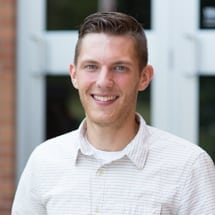Countercultural roots of Eastern Christian School
In response to major developments in the century-long “school struggle” taking place in the Netherlands in the nineteenth century, a group of Dutch immigrants decided to take preemptive action in Paterson, NJ.
Back in the Netherlands, legislation removed biblical teachings from public school curriculum while simultaneously eliminating government funding of religious schools. Recognizing that cultural winds had shifted dramatically in Europe and that the United States was sure to follow, this small group in Paterson took preemptive action. Many in the group foresaw the inevitable cultural conflict brewing between the teachings of the church and Christian home and the increasingly godless cultural developments in American society. By undertaking the socially and fiscally strenuous task of starting a Christian school, this group laid an additional foundational pillar in the way, the truth, and the life of Christ, working in conjunction with the Christian family and the Christian Reformed Church (Bontekoe 12). The result was Amity Street Christian School, a group of seventy students and two teachers, which after several generations and much expansion, is now the Eastern Christian School Association.
Immediately upon founding, however, a philosophical conflict emerged: religious isolationism or cultural engagement … Or, to simplify, when and how should we integrate the secular trends of our world into the education of our children? Quickly, it seems, the cultural engagement mindset won out, which should come as no surprise, since Abraham Kuyper’s influence in the Netherlands, on the broader Christian Reformed Church in America, and on the small group in Paterson is indelible.
One of the key goals of true Christian education is not to hide but to engage in the culture in which we find ourselves. In “The Design of Christian Education” by Edwin H. Palmer, an article published in Christian Home and School in 1979, he writes, “God demands that we honor and acknowledge Him with our minds… He wants our children to think about and react correctly toward… every subject there is” (3).
During the First World War, the community began in earnest to consider adding a high school to what had become North Fourth Street Christian School. The idea was born out of three distinct motives: to combat the cultural degradation found in the public schools, to provide professional training for high paying jobs, and to continue the development of the Christian soul, mind, and body. During the First World War, the Bible was still being taught in the public schools, but neither the curriculum nor the philosophy of the public schools was God-centered (Bontekoe 15). Again with the Lord’s blessing, Eastern Academy was born, and its first class graduated in 1919.
In fact, Dr. Palmer’s earlier discussed, succinctly expressed idea is one of the foundational motives for Eastern Academy. References, explanations, and philosophical exegesis to EC’s commitment to existing as a bulwark against the tides of secularism and modernism are rife in the historical documents, found as early as the conceptional meetings of the 1890s, through the World Wars, and explicitly examined later in Eastern Christian’s 1962 “Statement of Philosophy,” as the school has always focused on “developing the whole human personality so that it would be better equipped for Christian service” (Bontekoe 16).
Consider the following tenets from EC’s “Statement of Philosophy” and consider how relevant they remain today:
- “[The Christian school] is an expression of a positive philosophy of life. Such a school symbolizes what should be the main concern of any society: the bringing together of man’s faith in God and his daily activity in ‘subduing the earth.’ Such an integration of religion and culture could help us escape the secularism that has corroded modern man’s values and efforts. It could also help achieve the real goal of all education, child and adult education, namely: to enjoy God and to glorify Him forever” (1-2).
- The results of Christian education should be recognized as follows: “a) a faith that God exists and that He has redemptively revealed Himself in Jesus Christ; b) an awareness that God’s existence and revelation make a difference for every part of life and learning and culture; and c) a conviction that there are unchanging principles of truth which makes systematic knowledge possible, of goodness which makes morality really binding, and of beauty which, because it is related to both truth and goodness, frees the spirit for its discovery and enjoyment” (2).
- “The school … has its own unique task to perform” in conjunction with the home and the church: “A school in the best tradition of schools” which additionally strives to be a “source of, and to perpetuate, a great good in the larger democratic society and cultural milieu in which it exists” (5).
The second statement is particularly striking; in today’s culture which unashamedly revels in perversion and ugliness and laughs at the idea of truth, how uplifting is it to consider our role as parents, teachers, and theologians in perpetuating God’s truth and beauty in the “larger democratic society and cultural milieu.” We should teach our children and our students the way of God and argue for His superiority by engaging other worldviews, so that when temptations come, our children and students are strong enough to resist. This includes forewarnings and examinations on everything from serious art to pop songs to foreign policy.
We here at EC remain committed to standing against the disharmony and confusion sowed by the secular world, and to continue to usher students down the “narrow” way, all the while engaging the theological and philosophical conflicts that exist while being in the world, but not of it. God’s calling for our lives does not change because of a new scientific discovery, technological development, or cultural opinion. If it did, God’s calling would be neither true nor eternal, and it would have slipped into obscurity long ago.
Martin Luther gives us a wonderful and comforting image of God as a “bulwark never failing:” He cannot be moved, and as long as our teaching remains true to Him, nor can we.
References
Bontekoe, Cornelius. An Historical Review of Eastern Academy. 1944.
Palmer, Edwin H. “The Design of Christian Education.” Christian Home and School, July 1979, pp. 3–4.
“Statement of Philosophy.” Contributed to by the Education Committee and ECSA School Board, Eastern Christian High School, October, 1962.





